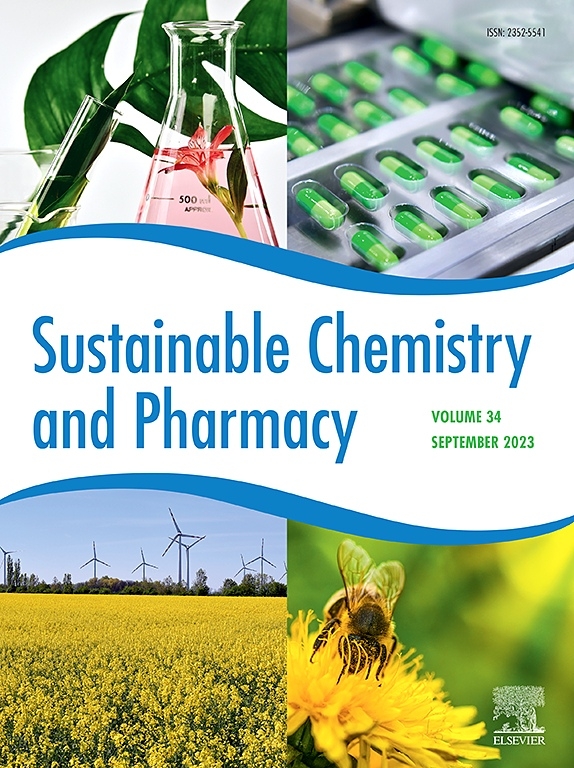Green and efficient depolymerization and recycling of polyester/cotton blended fabrics by ethanolamine
IF 5.5
2区 化学
Q2 CHEMISTRY, MULTIDISCIPLINARY
引用次数: 0
Abstract
The improper treatment of waste polyester/cotton blended fabrics results in significant environmental pollution and resource wastage, and there is an urgent necessity to address the efficient treatment of waste polyester/cotton blended fabrics. The present study employs a more environmentally friendly, gentle, and energy-efficient approach to effectively separate and recycle waste polyester/cotton blended fabrics. Firstly, the waste polyester/cotton blended fabrics are swollen using acetic acid to increase the gaps of the polyester molecular chain to facilitate contact between the polyester and the depolymerization solvent. Then, the polyester of the polyester/cotton blended fabrics was efficient degraded by ethanolamine and the regenerated cotton fibers were separated after simple filtration. The effects of pretreatment condition, depolymerization temperature and time on the depolymerization efficiency of polyester under atmospheric pressure and catalyst-free conditions were investigated, and the regenerated cotton were characterized and compared with virgin cotton. Considering the comprehensive energy consumption and other factors, the optimal swelling conditions were 40 °C for 50 min. The optimal depolymerization conditions were 80 °C for 3 h, and the depolymerization rate of polyester reached 96.00 %. The chemical structure and crystal structure of regenerated cotton is comparable to that of virgin cotton, and the tensile properties are weakened by about 0.67 N. Polyester depolymerization product bis(2-hydroxyethyl)terephthalamide (BHETA) can be used as a precursor for foams and adhesives. The “polyester dissolution for cotton retention” technology enables high-added-value utilization of waste polyester/cotton blended fabrics. The wide application of this technology is of great significance to the economy, ecological and environmental protection.

乙醇胺对涤棉混纺织物的绿色高效解聚和回收利用
废旧涤棉混纺织物的处理不当造成了严重的环境污染和资源浪费,迫切需要解决废旧涤棉混纺织物的高效处理问题。本研究采用了一种更环保、温和、节能的方法来有效地分离和回收废涤棉混纺织物。首先,对废涤棉混纺织物进行醋酸膨胀,增加聚酯分子链的间隙,促进聚酯与解聚溶剂接触。然后,用乙醇胺对涤棉混纺织物中的涤纶进行高效降解,并对再生棉纤维进行简单过滤分离。研究了预处理条件、解聚温度和时间对常压和无催化剂条件下聚酯解聚效率的影响,并对再生棉进行了表征,并与原棉进行了比较。综合能耗等因素,最佳溶胀条件为40℃、50 min,最佳解聚条件为80℃、3 h,聚酯解聚率达到96.00%。再生棉的化学结构和晶体结构与原棉相当,拉伸性能下降约0.67 n。聚酯解聚产物双(2-羟乙基)对苯二甲酸乙酯(BHETA)可作为泡沫和粘合剂的前驱体。“溶涤保棉”技术实现了废涤棉混纺织物的高附加值利用。该技术的广泛应用对经济、生态和环境保护具有重要意义。
本文章由计算机程序翻译,如有差异,请以英文原文为准。
求助全文
约1分钟内获得全文
求助全文
来源期刊

Sustainable Chemistry and Pharmacy
Environmental Science-Pollution
CiteScore
8.20
自引率
6.70%
发文量
274
审稿时长
37 days
期刊介绍:
Sustainable Chemistry and Pharmacy publishes research that is related to chemistry, pharmacy and sustainability science in a forward oriented manner. It provides a unique forum for the publication of innovative research on the intersection and overlap of chemistry and pharmacy on the one hand and sustainability on the other hand. This includes contributions related to increasing sustainability of chemistry and pharmaceutical science and industries itself as well as their products in relation to the contribution of these to sustainability itself. As an interdisciplinary and transdisciplinary journal it addresses all sustainability related issues along the life cycle of chemical and pharmaceutical products form resource related topics until the end of life of products. This includes not only natural science based approaches and issues but also from humanities, social science and economics as far as they are dealing with sustainability related to chemistry and pharmacy. Sustainable Chemistry and Pharmacy aims at bridging between disciplines as well as developing and developed countries.
 求助内容:
求助内容: 应助结果提醒方式:
应助结果提醒方式:


